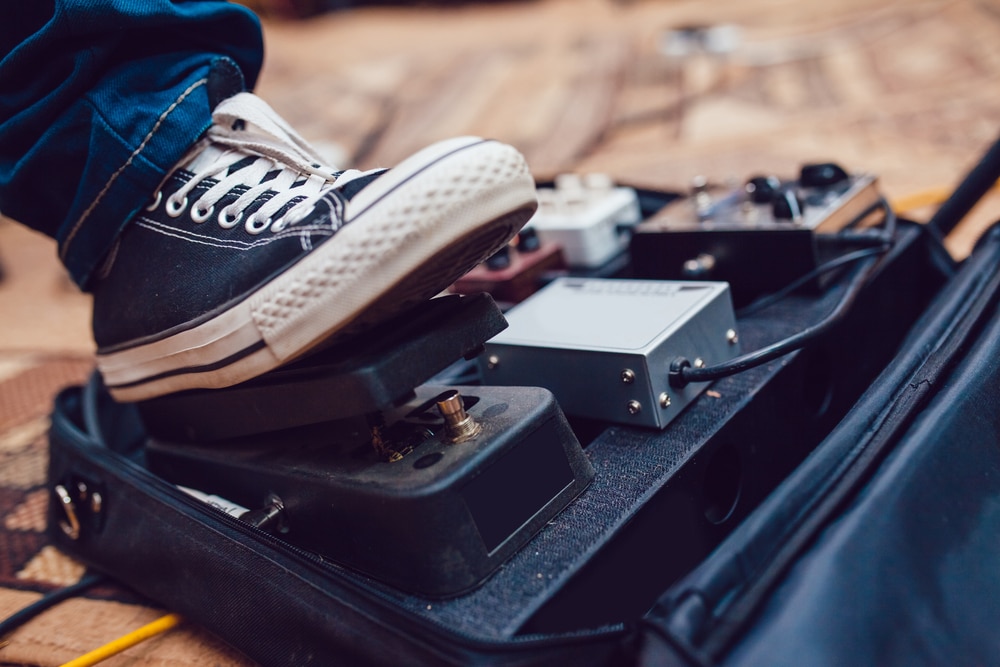A good guitar requires a decent guitar pedal, especially if you plan on performing intricate, complex pieces. One of the main issues with guitar pedals is that they don’t all meet a specific standard in terms of acoustics and responsiveness. That means decisions are usually made according to more subjective criteria. So, what characterizes a good guitar pedal? This article will take you through the basics so you can make an informed choice.
Contents
What Is a Guitar Pedal?
If you’re a beginner and just learning how to play the guitar, you would have surely heard of a guitar pedal. They’re special gadgets that connect to your amplifier and guitar and help to produce a variety of sounds and effects. They include connection points for your guitar input and output going to your amplifier.
The top of the pedal comes designed with a special footswitch that’s utilized manually to switch the pedal on and off. With various types of guitar pedals available including their effects and variations, it can be a challenging task to choose one that suits your needs the best; even more so if you’re a student of a specific music style.
Types of Guitar Pedals
Whether you own an electric, acoustic or bass guitar, various types of guitar pedals can be utilized to enhance and add sound effects to your playing. However, there are some key types that you should be aware of when buying the right one for you and the kind of music genre you play. Although they rarely differ in terms of design and general-purpose, guitar pedals do indeed differ in regards to the output they deliver.
Compressor
This function produces a punchy effect, stabilizes the volume level and adds smoothness.
Distortion
One of the common sound effects, this type gives a fuzzy grit effect. This effect distorts the original sound adding an overtone that may sound very loud but isn’t.
Reverb
Reverb is another common type of effect that gives the sound effects of sitting in a large hall like a cathedral.
Delay
This type of effect is delayed as the name suggests, leaving you with an instant echo effect, adding a similar tone and audio signal just after the original.
Chorus
Similar to the reverb effect, this one creates a choir-like sound owing to the changes in pitch. It also produces a slight delay to the original sound signal.
Wah
This type of effect produces a sound that depends on how you position the foot pedal. It adds a great “wah” sound to the rhythm you play.
Flanger
Producing a spacey sound, this effect inverts the audio signal produced, giving you shorter delay times.
Phaser
Producing tiny ripple effects, a phaser amplifies certain sounds and diminishes others by breaking the signal into two.
Multi-Effects
These pedals are much more expensive than single effects pedals. Giving you a variety of sounds effects, this type can produce tones that sound like different instruments.
Important Considerations When Buying Guitar Pedals
Budget
Guitar pedals aren’t cheap. Some might be priced at affordable rates, but do they cater to your requirements? How much can you spend? Choose a pedal that produces the sound effect you need. If you require more than one, budget your finances depending on the various brands and their ratings and reviews. If you require more than 2 effects, it’s perhaps better you choose a multi-effect pedal as it’s much cheaper than single effects guitar pedals.
Type
Make sure you know the type of guitar pedal you require. As mentioned above, if you need more than one or two effects, it’s recommended that you go for a pedal that comes with a variety of sound effects. A versatile piece that usually commands a price tag to match. If, however, you’re new to playing the guitar, you can gradually grow and enhance your skills while choosing one type of pedal at a time to grow your pedal board experience.
Brand
It’s important to go for a brand that’s well known and easily recognizable, and yet there are lesser brands that meet roughly the same standards. Look for brands that are used by other aspiring musicians or even professionals. Devices that enjoy their fair share of positive reviews that you can study, to help determine the right brand for you, keeping in mind your budget as well.
Watch Demos
Most pedals available today come with demo videos to help buyers understand the working functions of each pedal. Always check these so that you can understand a pedal’s features before making a purchase. The best way to do that is to check and see if the manufacturers included any type of demo that you can learn from. At the very least, you’ll gain a deeper understanding of what a good pedal should be all about.
Bottom Line
Acquiring guitar pedals can be hectic, especially if you do not know the type of effects each one comes with. Guitar pedals can break or make your general tone and sound of a guitar. Having a good amplifier and guitar helps in making basic guitar and amplitude sound.
However, with the support of a good guitar pedal, your solos and sound will be out of this world. The best guitar pedal doesn’t have to be expensive. Even the best ones can be purchased at an accessible price.

